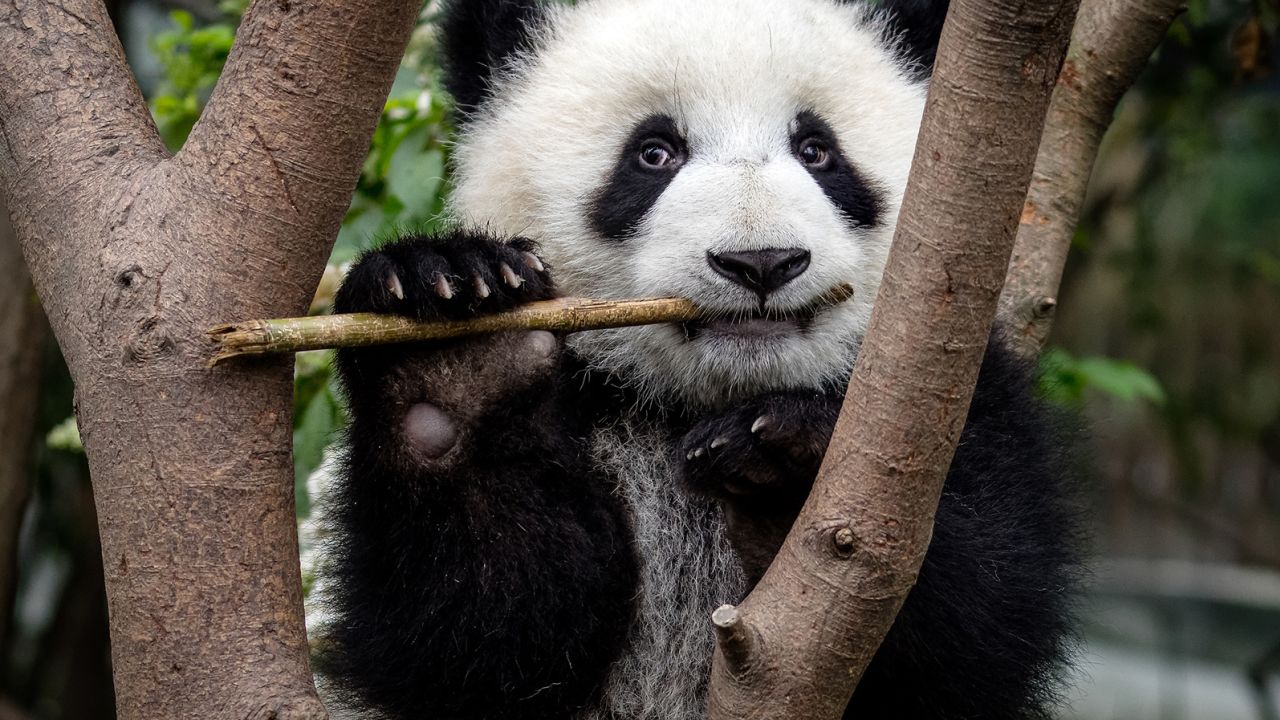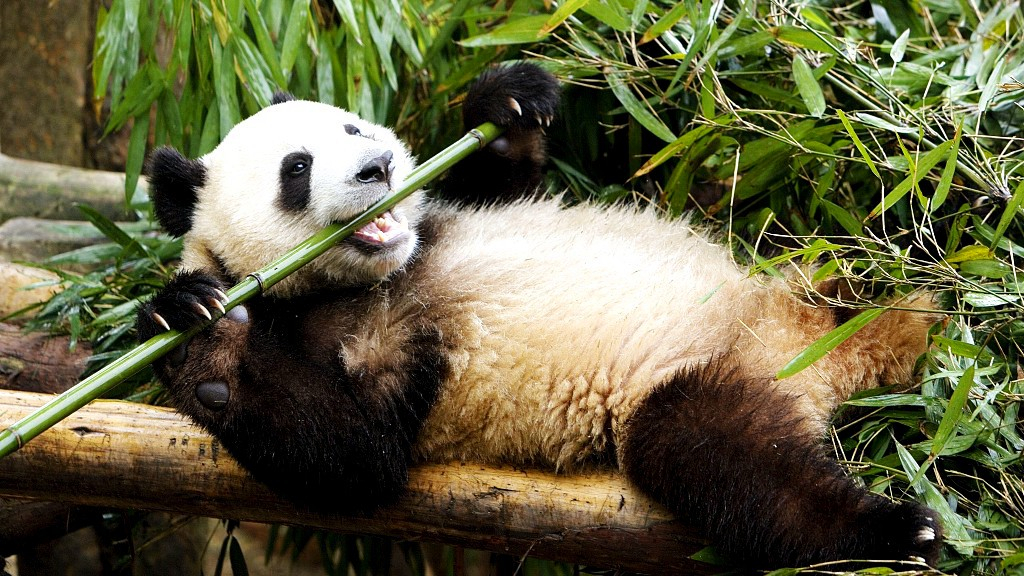Giant pandas possess many specialized physical and behavioral adaptations that allow them to survive in the lush bamboo forests of China.
Their trademark black and white coloring provides camouflage, and they have evolved unique chewing abilities to extract nutrients from their fibrous vegetarian diet.
Read on to learn more about the panda’s clever adaptations that help them thrive in their specialized habitat.
How Do Pandas Adapt to Their Environment?

Giant pandas have evolved specialized physical traits and behaviors to thrive on their bamboo-rich diets in the lush mountain forests of China.
These adaptations include versatile pseudo-thumbs, thick insulating fur, expanded molar surfaces, and energy-conserving lifestyles.
Pandas are remarkably adapted to extract nutrients and remain concealed in their unique forest habitat.
Key Points
- Thick fur provides insulation and camouflage for their cool forest home.
- Modified wrist bones and pseudo-thumbs allow easy grasping of bamboo.
- Lengthened molar surfaces and gut flora digest tough bamboo.
Why Do Pandas Eat Only Bamboo?

Pandas subsist almost entirely on bamboo despite their taxonomic classification as carnivores.
Bamboo’s year-round availability provides a reliable food source.
Pandas have evolved digestive adaptations like expanded molar surfaces to grind the fibrous stalks with tooth enamel reinforced with extra calcium.
Short intestines and gut microbes help extract nutrients from the difficult-to-digest bamboo.
Additionally, pandas conserve energy by moving minimally and limiting their bamboo consumption, unlike other herbivores that must forage extensively.
Pandas satisfy their low caloric needs by selectively eating bamboo high in energy and low in toxins.
How Does a Panda’s Fur Help It Adapt?
Thick, dense fur insulates pandas from their chilly, damp mountain forest habitat.
Their bold black and white markings form camouflage among forest trees and shade patterns.
Pandas molt and shed their fur to adapt to seasonal temperature shifts.
The purpose of the panda’s sometimes rust-colored fur remains a mystery but may provide additional camouflage or protection from the sun’s UV rays.
Overall, the panda’s specialized fur coat, which is its adaptive trait, enables heat retention and concealment within its cool bamboo forest ecosystem.
Why Do Pandas Sleep So Much?
Pandas spend 10-16 hours per day sleeping to conserve energy on their nutrient-poor bamboo diet.
Their slow-moving lifestyle and limited feeding hours contrast other herbivores.
Sleeping aids digestion and allows pandas to re-ingest nutrients in their feces while denning.
Short digestive tracts and gut morphologies adapted for extracting nutrients also necessitate lengthy digestion times.
Sleep further minimizes energy expenditure for survival on limited calories.
Pandas’ low-energy lifestyle reflects specialized adaptations enabling bamboo to sustain them sufficiently.
How Do Pandas Use Their Paws and Claws to Adapt?
Pandas have five finger-like digits plus an opposable pseudo-thumb that facilitates climbing and grasping bamboo.
Wrist bones work as thumbs to grip stalks.
Semi-retractable claws also help grip bamboo but aren’t as sharp as carnivores’ claws.
Broad paw pads provide traction on wet, snowy, or rocky terrain.
An enlarged radial sesamoid bone reinforces the wrist for supporting body weight.
These specialized paws adeptly strip and manipulate bamboo while providing agility in their forested mountain habitat.
How Have Pandas Adapted to Their Forest Habitat?
In addition to their camouflaging black and white fur, pandas blend into their forest home by climbing, resting, and seeking shelter among the trees.
Their coloring hides them amidst dappled light and dark forest backgrounds.
Pandas vocalize only occasionally to avoid detection.
Their claw structure suits tree climbing better than hunting.
Digestive and wrist adaptations allow pandas to thrive on plentiful forest bamboo.
Peaceful temperaments reduce conflict over their limited food source.
Pandas’ solitary nature and camouflage aid their stealthy survival in China’s dense bamboo forests.
How Do Pandas Stay Warm in Cold Temperatures?
Dense, oily fur provides insulation and waterproofing that pandas need in China’s chilly, damp mountain habitats.
Fat deposits up to 4 inches thick also minimize heat loss.
Pandas acclimate by sunbathing on warmer days to build heat reserves.
During cold snaps, they den inside hollow tree trunks, rock crevices, caves, or dug-out holes for shelter.
Cubs are born with extra fur for warmth. pandas also spend winter days basking in the sun.
By conserving energy and adapting their behavior and fur density through the seasons, pandas regulate their temperature year-round.
What Adaptations Do Pandas Have to Protect Themselves?
Giant pandas have several key adaptations that help protect them from predators and other threats:
Thick white and black fur provides camouflage in their snowy, forested habitat, concealing them from predators.
Pandas have powerful jaw and cheek muscle strength to crush tough bamboo for self-defense.
Their bites can be dangerous.
Long claws aid in climbing trees to escape predators like leopards and tigers.
Cubs instinctually climb upon threat.
Their black ears, eye patches, legs, and shoulders look like formidable facial features and body size as a warning.
Pandas vocalize with barks, growls, and bleats to alert others of danger or scare off threats.
Cubs vocalize loudly when in distress to summon parents for protection and help.
Pandas mostly live solitary lives to avoid competition over bamboo terrain and minimize conflicts.
Their conservation status has allowed greater protection efforts to preserve their populations.
How Do Pandas Evolve and Adapt?
Pandas evolved specialized physical and behavioral adaptations over millennia to their unique bamboo niche:
Digestive adaptations like expanded molar surfaces evolved to extract nutrients from fibrous bamboo.
Wrist flexibility, pseudo-thumbs, and grip evolved for grasping bamboo.
Black and white coloring developed as camouflage within their forest habitat.
Low-energy lifestyles and round compact shapes evolved to conserve calories from nutrient-poor bamboo.
Solitary behavior reduces competition for local bamboo and minimizes conflicts.
Reduced aggression and predation risk allowed focus on foraging bamboo over time.
As bamboo availability fluctuated, pandas adapted by expanding or shifting their home ranges.
Vocalizations and scent markings evolved for communicating territories across dispersed bamboo.
Are Pandas Well Adapted?
Yes, giant pandas display incredible specialization in their local bamboo-rich habitats through digestive, anatomical, and behavioral adaptations. These include:
Unique wrist flexibility, pseudo-thumbs, and claws to grasp and strip bamboo stalks.
Lengthened molar surfaces, strong jaw muscles, and gut flora to extract bamboo nutrients.
Dense, oily fur for insulation and camouflage in their cool, humid mountain forests.
The energy-conserving lifestyle of sleeping and resting up to 16 hours per day.
Solitary nature to reduce feeding competition over local bamboo supplies.
Camouflage coloration and quiet habits to avoid detection.
Overall, pandas exhibit remarkable adaptations enabling their unique low-energy, bamboo-centric lifestyle.
What are 2 Behavioral Adaptations of a Panda?
Two key behavioral adaptations of giant pandas are:
Their solitary, territorial lifestyle.
Pandas maintain large home ranges with limited overlap to reduce competition over the limited local bamboo.
This minimizes aggression and conflict.
Pandas spend up to 16 hours per day resting and sleeping.
Their low-energy lifestyle conserves calories since bamboo provides limited nutrients.
Sleeping aids bamboo digestion while also reducing foraging needs.
Additional behavioral adaptations include vocalizing to communicate warnings or territory boundaries from a distance.
Pandas also exhibit energy-minimizing feeding behaviors like continuously grazing on bamboo versus relocating.
Their docile temperaments help avoid competition and facilitate camouflage.
Key Takeaways:
- Giant pandas display a range of specialized physical and behavioral adaptations enabling their unique bamboo-based lifestyle.
- By evolving to thrive in their specialized forest niche, giant pandas exemplify the amazing biodiversity made possible by natural selection.
FAQ
Why Do Pandas Eat Bamboo?
Pandas subsist on bamboo for its year-round availability in their habitat. They have digestive adaptations to extract nutrients from the fibrous stalks.
How Much Time Do Pandas Spend Sleeping?
Pandas conserve energy by sleeping 10-16 hours per day. Their slow-moving lifestyle aids bamboo digestion.
Are Pandas Endangered?
Yes, pandas are classified as vulnerable to extinction primarily due to habitat loss. Only around 1,800 remain in the wild.
GreenChiCafe is your source for the latest research on amazing wildlife adaptations.
Visit our site to learn more about endangered species conservation.
